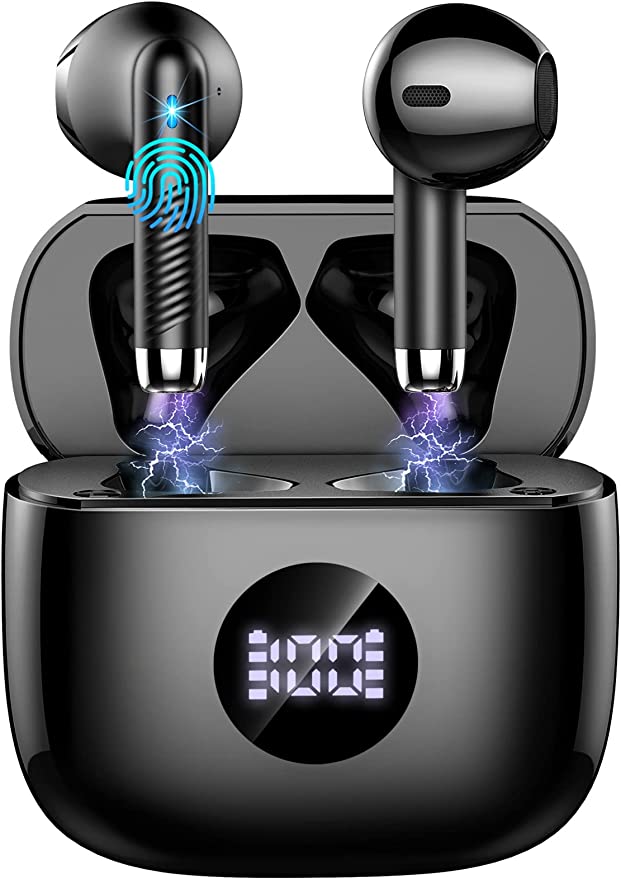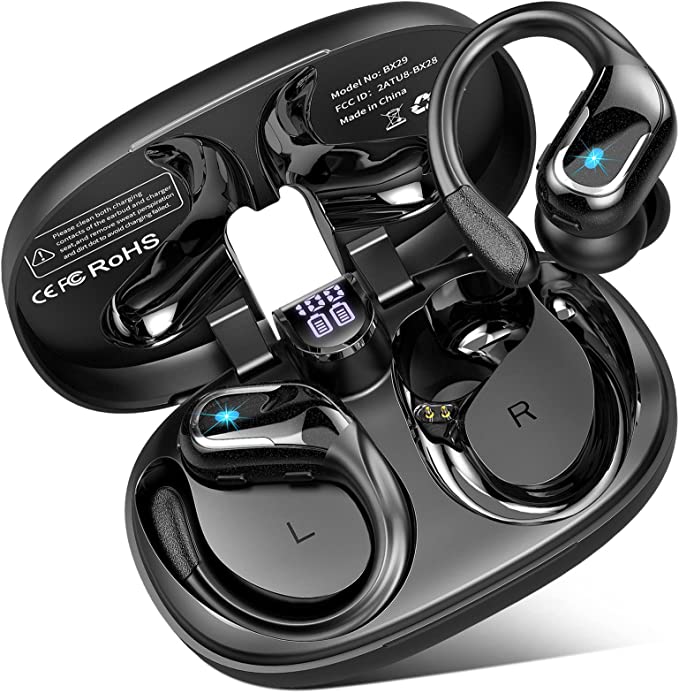We live in a world increasingly untethered, our soundtracks woven into the fabric of our days through tiny, wireless companions nestled in our ears. Commutes transform into podcast seminars, workouts find their rhythm with energizing playlists, and quiet moments are filled with immersive audiobooks. The journey from bulky, wired headphones to the sleek, truly wireless earbuds we see everywhere has been remarkable. But as this technology matures, a fascinating trend emerges: features once reserved for premium price tags are now appearing in remarkably affordable options.
Take the Jxrev J53-4 wireless earbuds, for example. They represent a category of products promising a suite of modern features – Bluetooth 5.3, noise-canceling microphones, long battery life, waterproofing – at a price point accessible to almost everyone. This raises intriguing questions for an engineer like myself: What technological choices and compromises enable this? How does the science translate into the actual user experience? Let’s put on our metaphorical lab coats and dissect the J53-4, not just as a product, but as a case study in the democratization of audio technology. Our exploration will rely on the manufacturer’s descriptions for specifications, viewing them through the lens of established scientific and engineering principles.

The Invisible Thread: Making Sense of Bluetooth 5.3
Every wireless experience begins with a connection. For the J53-4, that connection is forged via Bluetooth 5.3. Think of Bluetooth as a sophisticated, invisible handshake between your earbuds and your phone or laptop. It’s a short-range radio technology designed for low power consumption and reliable data transfer. Now, version numbers in Bluetooth aren’t just marketing fluff; they signify real evolution under the hood.
While manufacturers’ implementations vary, Bluetooth 5.3, as defined by the Bluetooth Special Interest Group (SIG), generally builds upon its predecessors by offering potential improvements in connection stability (fewer dropouts), enhanced efficiency (potentially contributing to better battery life), and often, faster initial pairing. Some underlying advancements in Bluetooth 5.3 also pave the way for future features like LE Audio, which promises higher quality audio at lower power consumption, though its implementation isn’t guaranteed in every device using the 5.3 standard.
For the Jxrev J53-4, the description highlights a “quick and stable” connection with “no delay or degradation.” This aligns with the general goals of the 5.3 standard. The convenience feature of automatically reconnecting when you open the case further leverages this wireless protocol. From a user’s perspective, the goal of Bluetooth 5.3 in a device like this is simple: a seamless, largely invisible connection that lets you focus on your audio, not on troubleshooting pairing issues. It’s the reliable foundation upon which the rest of the listening experience is built.

Crafting Your Personal Sound Bubble: The 13mm Driver’s Role
Once connected, how do these tiny earbuds actually produce sound? The magic happens within the dynamic drivers. Imagine a traditional loudspeaker, shrunk down significantly. Inside each J53-4 earbud (according to the description) resides a 13mm dynamic driver. At its core, a tiny electromagnet rapidly vibrates a thin membrane, the diaphragm. This diaphragm “dances” back and forth, pushing air and creating the pressure waves our ears interpret as sound.
The size of the driver – 13mm in this case – is often highlighted. Physics tells us that, all else being equal, a larger diaphragm has the potential to move more air. This greater air displacement can translate into an ability to reproduce lower frequencies (bass) more effectively and potentially achieve higher overall volume levels. This is likely why the J53-4 is described as offering “deep, rich bass” and a “richer audio experience.”
However, driver size is only one part of the complex equation of sound quality. Think of it like the size of an engine in a car – it indicates potential, but performance depends heavily on how the entire system is engineered. The tuning of the driver – how the engineers shape its frequency response through acoustic design and potentially digital signal processing – is paramount. Materials used in the diaphragm, the enclosure design, even the shape of the ear tip (though these are semi-in-ear) play crucial roles.
When a budget-friendly earbud claims “Hi-Fi stereo sound,” it’s generally aiming for a pleasant, balanced, and clear listening experience across the frequency spectrum, rather than the absolute accuracy and nuanced detail pursued by high-end audiophile gear. For the J53-4, the 13mm drivers likely provide a solid foundation for delivering that satisfying fullness, especially noticeable in pop, electronic, or hip-hop music where bass presence is key. They create that personal sound bubble where your music can come alive.

Can You Hear Me Now? The Art of ENC in a Noisy World
Wireless earbuds aren’t just for listening; they’re communication tools. But making clear calls in the hustle and bustle of modern life can be a challenge. Enter noise cancellation technology. It’s crucial here to distinguish between two types: ANC (Active Noise Cancellation), which silences the outside world for you, the listener, and ENC (Environmental Noise Cancellation), which cleans up your voice for the person on the other end of the call. The Jxrev J53-4 features ENC, according to its description.
Imagine trying to talk on the phone while walking down a busy street or sitting in a noisy café. Your voice competes with traffic, chatter, and clatter. ENC acts like a smart filter specifically for your microphone feed. While specific implementations vary, the basic principle often involves using multiple microphones on the earbuds. One or more mics focus on picking up your voice, while others are strategically placed to capture the ambient background noise. Sophisticated algorithms then analyze these signals, identify the unwanted environmental sounds, and subtract them from the microphone signal before it’s transmitted.
Think of it as a tiny sound engineer inside your earbud, trying to isolate your voice and push the background noise into the shadows. The J53-4 description claims its ENC can “reduce the environmental noise by up to 35dB.” It’s wise to view such specific decibel figures, especially in budget devices, as likely representing performance under optimal, possibly laboratory, conditions. Real-world effectiveness will depend heavily on the type and volume of the noise, the quality of the microphones, and the sophistication of the noise-reduction algorithm. The primary goal isn’t usually to achieve perfect silence for the listener, but to significantly improve the intelligibility of your voice, making conversations less strained and more productive, even when the world around you isn’t cooperating.

Powering Your Playlist Marathon: Battery Life and Smarter Charging
All this wireless wizardry needs power. Like most modern portable electronics, the J53-4 earbuds and their case almost certainly rely on Lithium Polymer (Li-Po) batteries. These are favored for their high energy density relative to their weight and their ability to be molded into the compact shapes required for tiny devices.
The longevity game is crucial for wireless earbuds. The J53-4 boasts an impressive claim: up to 8 hours of playback from the earbuds themselves on a single charge, with the pocket-sized charging case holding enough juice for approximately four additional recharges, leading to a total potential playtime of around 40 hours. This kind of endurance frees users from constant “charger anxiety.” Achieving this involves a balance between battery capacity and the power efficiency of all the components, including the Bluetooth 5.3 chip which, as mentioned, generally aims for improved energy management. Of course, real-world battery life is always variable – listening at higher volumes or using specific audio codecs can drain the battery faster.
Beyond raw hours, charging convenience matters. The adoption of the USB-C charging port is a welcome standard, meaning one less type of cable to carry. The claim of a full recharge in just one hour is also quite practical for quick top-ups.
However, perhaps the most user-friendly power feature highlighted in the J53-4’s description is the LED power display on the case. Many budget earbuds offer vague indicator lights, leaving you guessing how much charge is really left. This display reportedly shows not only the remaining percentage of the case’s battery but also the charge level of each individual earbud in real-time. This seemingly small detail is a significant win for usability, eliminating the frustrating surprise of grabbing your earbuds only to find one is unexpectedly dead. It’s a thoughtful touch that enhances the everyday ownership experience.

Everyday Resilience: Waterproofing and Wearing Comfort
Life isn’t lived in a pristine lab. Earbuds need to survive sweat, maybe a sudden downpour, and the general rigors of daily use. The Jxrev J53-4 comes with an IP7 waterproof rating. Let’s decode that “IP” code. It stands for Ingress Protection, an international standard. The first digit (missing here, often replaced by ‘X’) relates to dust protection, while the second digit relates to water protection. A ‘7’ signifies a high level of water resistance – specifically, the device is protected against the effects of temporary immersion in water up to 1 meter deep for up to 30 minutes under specified conditions.
What does this mean practically? You shouldn’t go swimming with IP7-rated earbuds, and high-pressure water jets are still a no-go. However, this rating provides solid peace of mind against sweat during intense workouts or getting caught in the rain during your run or commute. The description also mentions an internal “nano-coating,” likely a hydrophobic treatment applied to components to further bolster moisture resistance.
Durability needs to be matched by comfort, especially for devices worn for extended periods. The J53-4 employs what’s described as an “ergonomic semi-in-ear” design. Unlike fully sealed in-ear monitors that penetrate deeper into the ear canal, semi-in-ear designs rest more gently in the outer ear. This can offer greater comfort for some users and allow more awareness of surroundings, but potentially at the cost of some passive noise isolation and bass seal compared to deeper-fitting designs. The claimed featherlight weight of just 3 grams per earbud is also a significant factor in long-term comfort, reducing pressure and fatigue. The goal is a “snug fit” that stays put during moderate activity without causing discomfort. Add the convenience of touch controls directly on the earbuds for managing music, calls, and volume, and the design aims for a blend of resilience and user-friendliness.

Conclusion: More Than Just the Sum of Its Parts
Deconstructing the Jxrev J53-4 wireless earbuds reveals a compelling narrative about modern technology. We see how established standards like Bluetooth continue to evolve (version 5.3), how fundamental physics dictates audio performance (13mm drivers), how sophisticated signal processing tackles real-world problems (ENC), how battery technology and clever design provide endurance and convenience (40H playtime, LED display), and how material science offers resilience against the elements (IP7).
What makes this particularly interesting is seeing these technologies integrated into a package aimed at affordability. It’s a testament to the relentless pace of innovation and manufacturing efficiency – features that were premium just a few years ago are now becoming standard expectations across different market segments. While we must remain mindful that product claims, especially for budget devices, are based on manufacturer descriptions and may represent ideal conditions, the underlying science is real.

Understanding the technology inside the gadgets we use every day does more than just satisfy curiosity. It empowers us. It helps us decipher marketing jargon, appreciate the engineering ingenuity involved (even in seemingly simple devices), and ultimately make more informed choices about the tools that shape our connected lives. The Jxrev J53-4, like many similar products, isn’t just a pair of earbuds; it’s a small window into the accessible, ever-evolving symphony of modern technology.




